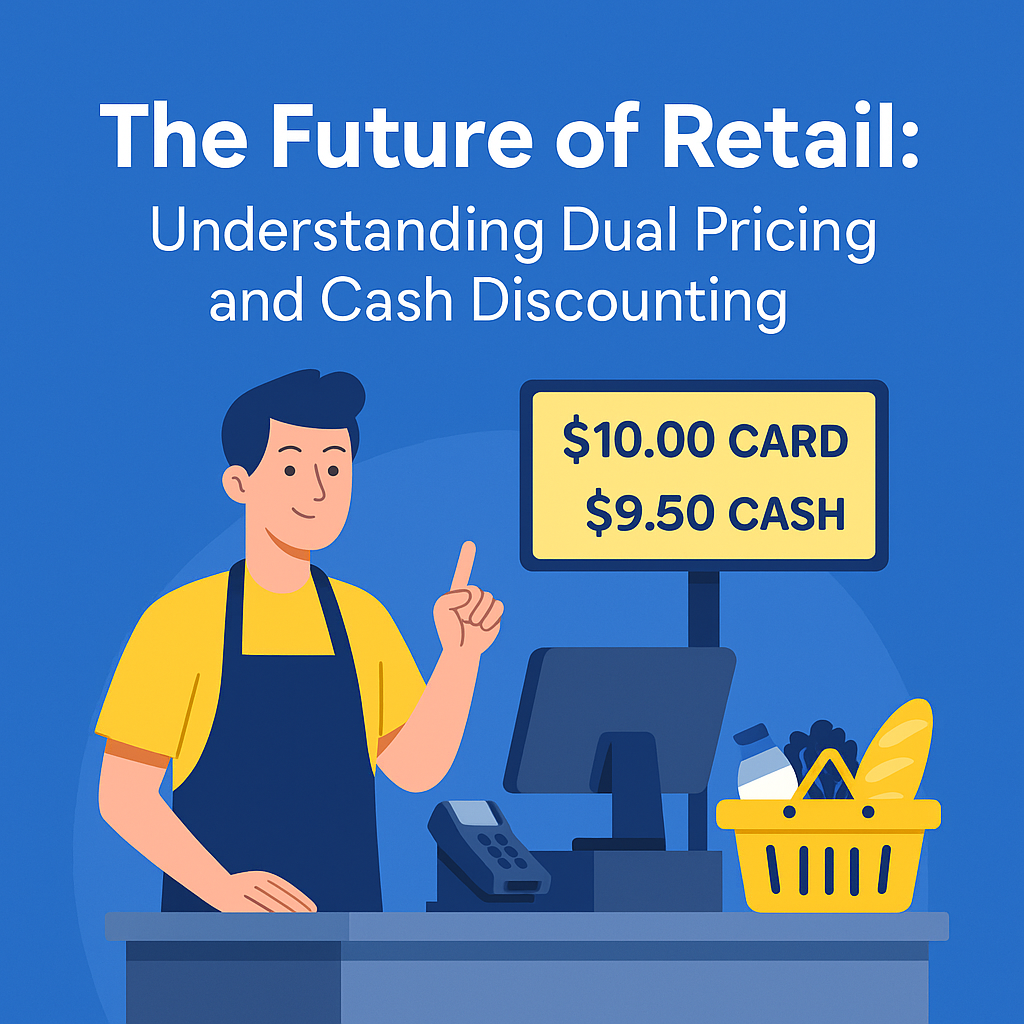In today’s fast-paced retail environment, businesses are constantly exploring innovative strategies to enhance their profitability while remaining competitive. Among these strategies, dual pricing and cash discounting have emerged as two compelling pricing models that promise to reshape the future of retail. In this comprehensive blog post, we will delve into the concepts of dual pricing and cash discounting, examine their benefits and challenges, and discuss their impact on retailers and consumers alike.
What is Dual Pricing?
Dual pricing is a pricing strategy where retailers display two different prices for their products or services—one price for customers who pay with cash and another for those who opt to use credit or debit cards. This model is designed to help merchants manage the costs associated with card transactions, which can significantly cut into profit margins. By encouraging cash payments, retailers can potentially improve their cash flow and lower the expenses related to payment processing fees.
In essence, dual pricing reflects the reality that different payment methods imply varied transaction costs for sellers. As the digital payment landscape evolves, dual pricing presents an adaptable response to the fiscal demands placed on retailers by payment processors.
For instance, a convenience store might list a bottle of water at $1.00 for cash buyers and $1.03 for card users. This difference, albeit small, offsets the transaction fees the merchant would otherwise absorb. When practiced transparently and in compliance with regulations, dual pricing helps level the playing field for retailers who otherwise shoulder increasing financial burdens from card networks.
What is Cash Discounting?
Cash discounting is a related yet distinct concept that entails offering customers a discount on their purchases when they pay in cash. This discount serves as an incentive for consumers to choose cash over card payments, effectively reducing the retailer’s transaction costs. Unlike dual pricing, which displays different prices categorically, cash discounting applies a single price to all items but rewards cash transactions through a price reduction.
Cash discounting strikes a delicate balance—it incentivizes customers to pay with cash while maintaining a simple and straightforward pricing model. This approach not only benefits retailers by minimizing transaction fees but also encourages tangible currency exchange, which can be advantageous in various economic contexts.
For example, a small café might price its coffee at $3.00 but apply a 4% discount for cash payments, reducing the final price to $2.88. This subtle but effective method shifts transaction costs without penalizing consumers outright, and often garners a positive reception among budget-conscious shoppers.
It’s important to note that dual pricing is not the same as surcharging, which involves adding a fee to a credit card transaction. Instead, dual pricing lists both the cash and card price clearly at the point of sale.
The Advantages of Dual Pricing and Cash Discounting
1. Reduced Transaction Fees
One of the most significant advantages of dual pricing and cash discounting is the reduction in transaction fees incurred by retailers. According to the National Retail Federation (National Retail Federation), swipe fees average 2.24% of the total transaction but can be as high as 4% for premium travel and rewards cards. Encouraging cash payments allows retailers to avoid these fees, which can significantly impact a business’s bottom line, particularly for enterprises with high transaction volumes or thin profit margins.
For small and medium-sized enterprises (SMEs), this difference can mean the ability to reinvest in their business or offer more competitive pricing, whether the savings are allocated toward marketing efforts, infrastructure upgrades, or employee wages, reduced fees free up resources that can drive sustainable business growth. Instead of silently absorbing transaction fees, these strategies allow merchants to make payment costs more transparent and manageable.
2. Improved Cash Flow
By promoting cash payments, retailers enhance their liquidity and cash flow. Cash transactions provide immediate access to funds, enabling businesses to reinvest in operations, pay suppliers, or cover operational costs without delay. For small businesses, where cash flow can often dictate success, this advantage is particularly critical.
Moreover, improved cash flow reduces reliance on credit lines or short-term loans. With more working capital readily available, retailers can operate with greater financial agility, respond faster to market demands, and navigate unforeseen expenses more effectively.
3. Customer Savings
Consumers who prefer cash payments can also benefit from discounts offered through cash discounting. Such savings can enhance customer loyalty, as many shoppers appreciate rewards for their payment choices. This aspect of dual pricing and cash discounting creates a win-win situation where both retailers and consumers stand to gain.
In an age where inflation and rising prices affect household budgets, even small savings at the point of sale can drive repeat business. Retailers that clearly communicate these benefits are more likely to foster positive brand perception and customer satisfaction.
4. Enhanced Control Over Payment Processing
With dual pricing and cash discounting, retailers can exert greater control over their payment processing systems. They can opt to eliminate certain credit card options or create separate pricing structures based on payment methods, ultimately allowing them to tailor their acceptance policies according to their business needs.
This flexibility is particularly valuable in sectors where margins are razor-thin. For example, gas stations, convenience stores, and food trucks often operate under such conditions. The ability to mitigate card fees without raising base prices for all customers can provide a crucial competitive edge.
Potential Challenges and Criticisms
1. Complexity and Confusion
While dual pricing and cash discounting can provide financial benefits, they may also introduce complexity and confusion for customers. Some consumers may be unaware of these pricing strategies, leading to frustration at the point of sale. Clear communication and signage are necessary to mitigate this issue and ensure people understand the reasoning behind pricing differences.
Businesses must invest in training staff to explain these models effectively and ensure that all promotional materials and receipts clearly outline the pricing structure. Transparency is essential to maintaining customer trust.
2. Legal and Regulatory Considerations
Legal frameworks regarding cash discounting and dual pricing vary across jurisdictions. While federal law in the United States permits these models under specific conditions, some states have more restrictive rules regarding the implementation of surcharges or required disclosures. For example, according to the National Conference of State Legislatures, a nonpartisan organization that tracks and reports on state-level legislation, several states have laws that limit the application of credit card surcharges or mandate clear disclosures about price differences based on payment method.
Retailers must carefully review state-specific regulations and consult legal experts to ensure compliance. Failure to do so could result in fines, legal disputes, or damage to a business’s reputation.
3. Impact on Consumer Behavior
While cash discounting aims to promote cash usage, it may unintentionally discourage consumers who predominantly use digital payment options. As society continues to gravitate towards technological solutions for transactions, relying heavily on cash may alienate certain segments of the customer base.
Retailers must assess their target demographic and weigh whether these pricing models align with their shoppers’ preferences. In highly digital markets, such as urban tech hubs, cash discounting may yield less impact or even deter patrons accustomed to contactless convenience.
4. Perception of Fairness
Some consumers may view dual pricing strategies as unfair or discriminatory, especially if they primarily use credit cards for their purchases. Retailers should weigh the implications of such perceptions and strive to ensure their pricing approaches align with customer expectations.
Communicating the rationale behind these strategies, such as transparency in processing fees and fairness in cost allocation, can help manage customer sentiment. Businesses that adopt a respectful and open communication strategy are more likely to maintain goodwill.
The Future of Retail with Dual Pricing and Cash Discounting
The evolution of retail is undoubtedly influenced by changing consumer preferences and technological advancements. As e-commerce continues to thrive, retailers are exploring innovative pricing models to differentiate themselves in a crowded marketplace. Dual pricing and cash discounting represent a proactive response to these challenges.
1. Adapting to Consumer Preferences
As consumer habits evolve, retailers must constantly adapt their practices to stay relevant. Offering pricing flexibility through dual pricing can empower consumers, providing them with choice and control over how they wish to pay. By creating a perception of value, retailers can enhance satisfaction and loyalty.
For example, younger shoppers who are more financially savvy may appreciate having the option to save by using cash. In contrast, older generations may see the transparency of pricing differences as a nod to traditional commerce. In both cases, offering options fosters inclusivity.
2. Embracing Technological Advancements
As payment technologies continue to advance, dual pricing and cash discounting can easily integrate with digital wallets and payment systems. This integration can create a seamless experience for both retailers and consumers, further solidifying these pricing strategies’ foothold in the future of retail.
Point-of-sale (POS) systems now support features that automatically apply cash discounts or show dual pricing clearly during checkout. With mobile apps and e-receipts, businesses can provide instant explanations, personalized offers, and track consumer behavior in real-time, enhancing both operations and marketing.
3. A Focus on Financial Awareness
As consumers become more financially conscious, strategies like dual pricing may indeed gain traction. Many consumers look for ways to save money and reduce unnecessary fees. Retailers who embrace cash discounting may gain an edge by aligning their practices with consumers’ growing financial awareness.
This shift toward financial literacy, particularly among Millennials and Gen Z, means that transparency around costs is no longer just appreciated—it is expected. Businesses that position themselves as allies in responsible spending can cultivate deeper brand loyalty and trust.
4. Sustainability and Cash Transactions
As sustainability becomes an increasingly hot topic, businesses may look for cash payment methods that entail fewer transaction costs and resources than card processing. The environmental implications of traditional banking systems are now coming to the forefront, urging retailers to rethink their payment options.
Reducing reliance on card networks, which involve energy-intensive infrastructure and plastic card production, may align with broader corporate sustainability goals. While cash itself has environmental considerations, digital banking’s carbon footprint is a growing concern, and retailers can contribute to sustainability by offering conscious payment alternatives.
Conclusion
In summary, dual pricing and cash discounting represent promising strategies for the future of retail that reflect the evolving payment landscape. While offering distinct advantages such as reduced transaction fees and improved cash flow, these models are not without their challenges. Retailers must navigate potential complexities and consumer perceptions to implement these strategies effectively.
As these practices gain traction, they possess the potential to reshape the very notion of value in retail, creating an environment where both retailers and consumers can benefit. Moving forward, it will be crucial for businesses to educate their customers, clearly articulate the benefits of cash payments, and adapt their operations to cater to the shifting retail landscape.
Retailers that harness the power of dual pricing and cash discounting wisely may find themselves well-positioned to thrive in an increasingly competitive marketplace.
Syncrostore supports cash discounting and dual pricing configurations out of the box, helping retailers stay compliant while reducing costs and increasing flexibility. Whether you’re looking to implement a dual price display or apply automated cash discounts at checkout, our tools make it simple.
As always, merchants should consult their payment processor or legal advisor to ensure compliance with local and federal regulations.
References
- National Retail Federation. https://nrf.com
- Forbes Advisor. “Credit Card Processing Fees and Costs.” https://www.forbes.com/advisor/business/credit-card-processing-fees/
- Visa. “Visa Core Rules and Visa Product and Service Rules.” https://usa.visa.com/support/consumer/visa-rules.html
- National Conference of State Legislatures (NCSL). “Credit Card Surcharges.” https://www.ncsl.org/financial-services-and-commerce/credit-card-surcharges
- Federal Reserve Bank. “Diary of Consumer Payment Choice 2023.” https://www.frbservices.org/resources/retail-payments/diary-of-consumer-payment-choice.html
- The Nilson Report. https://nilsonreport.com



